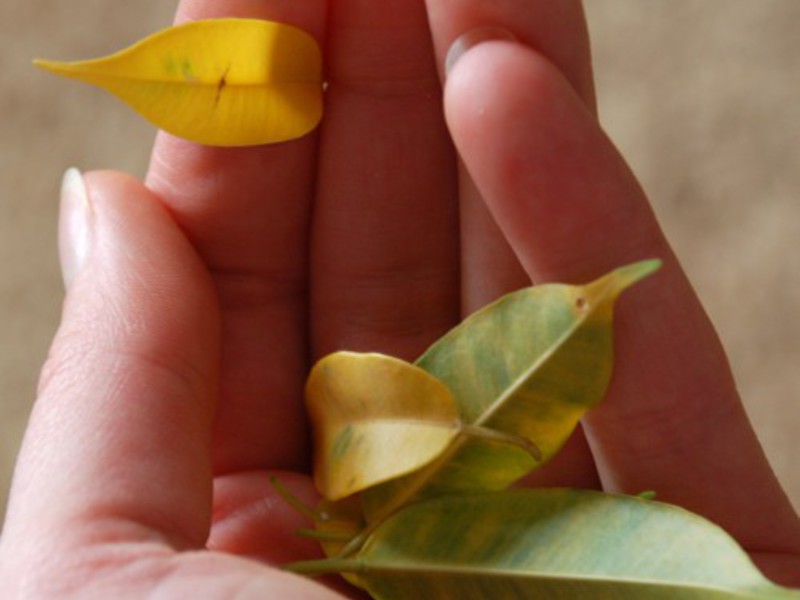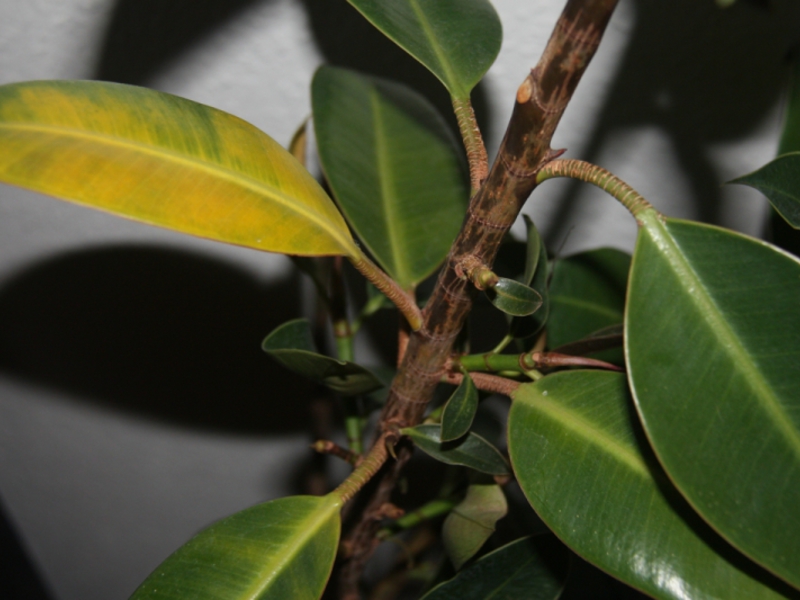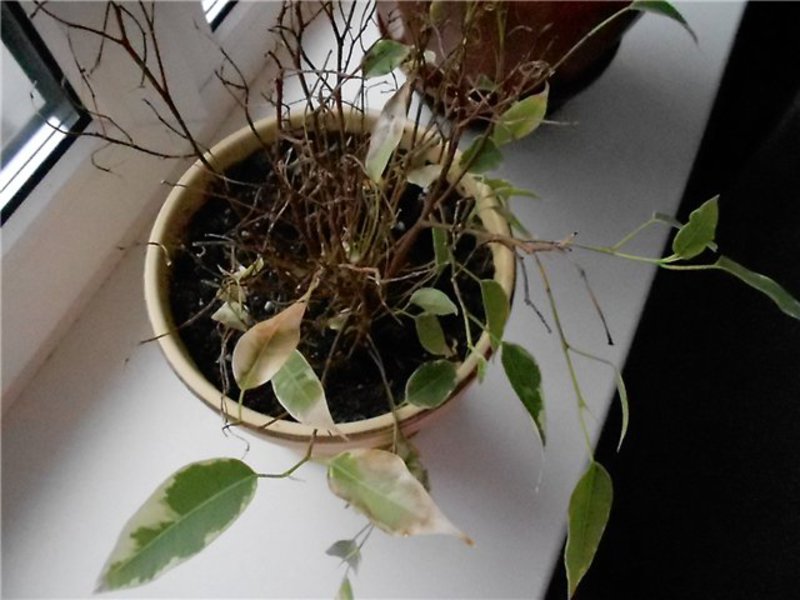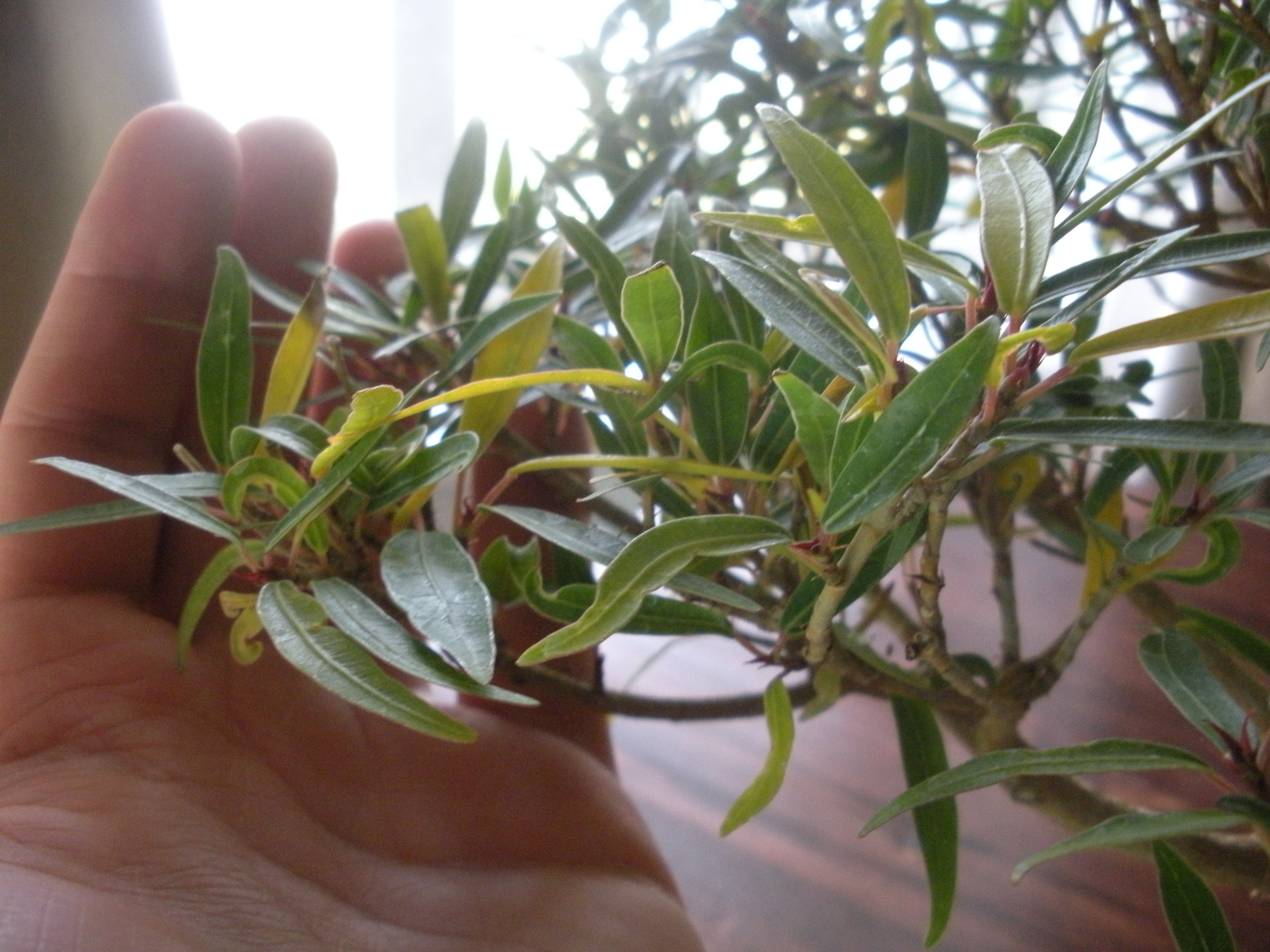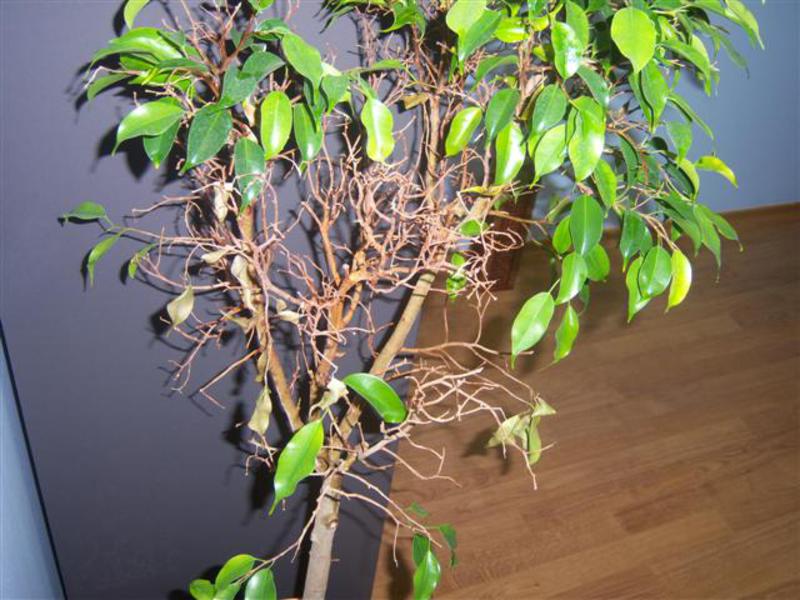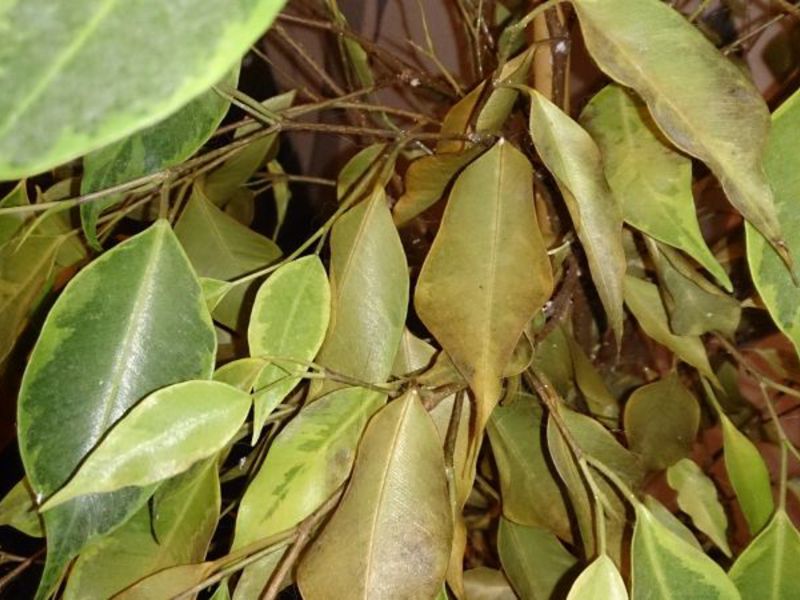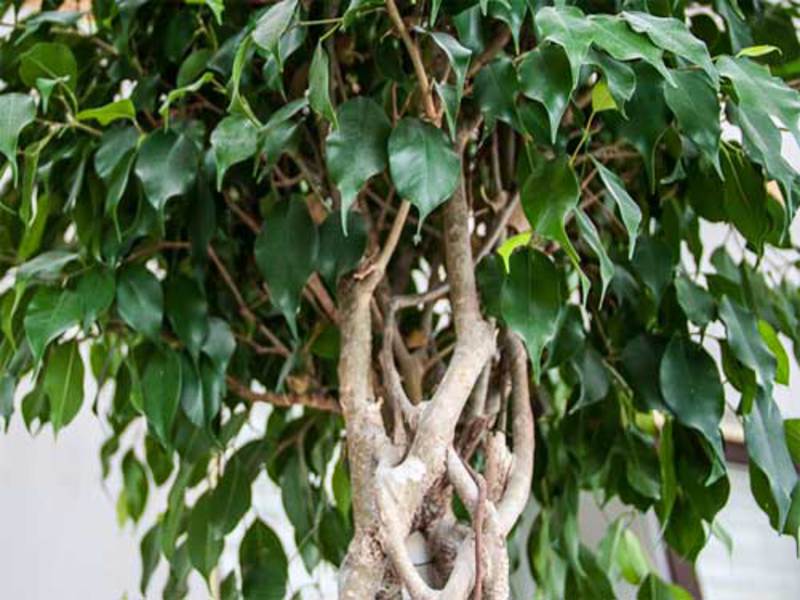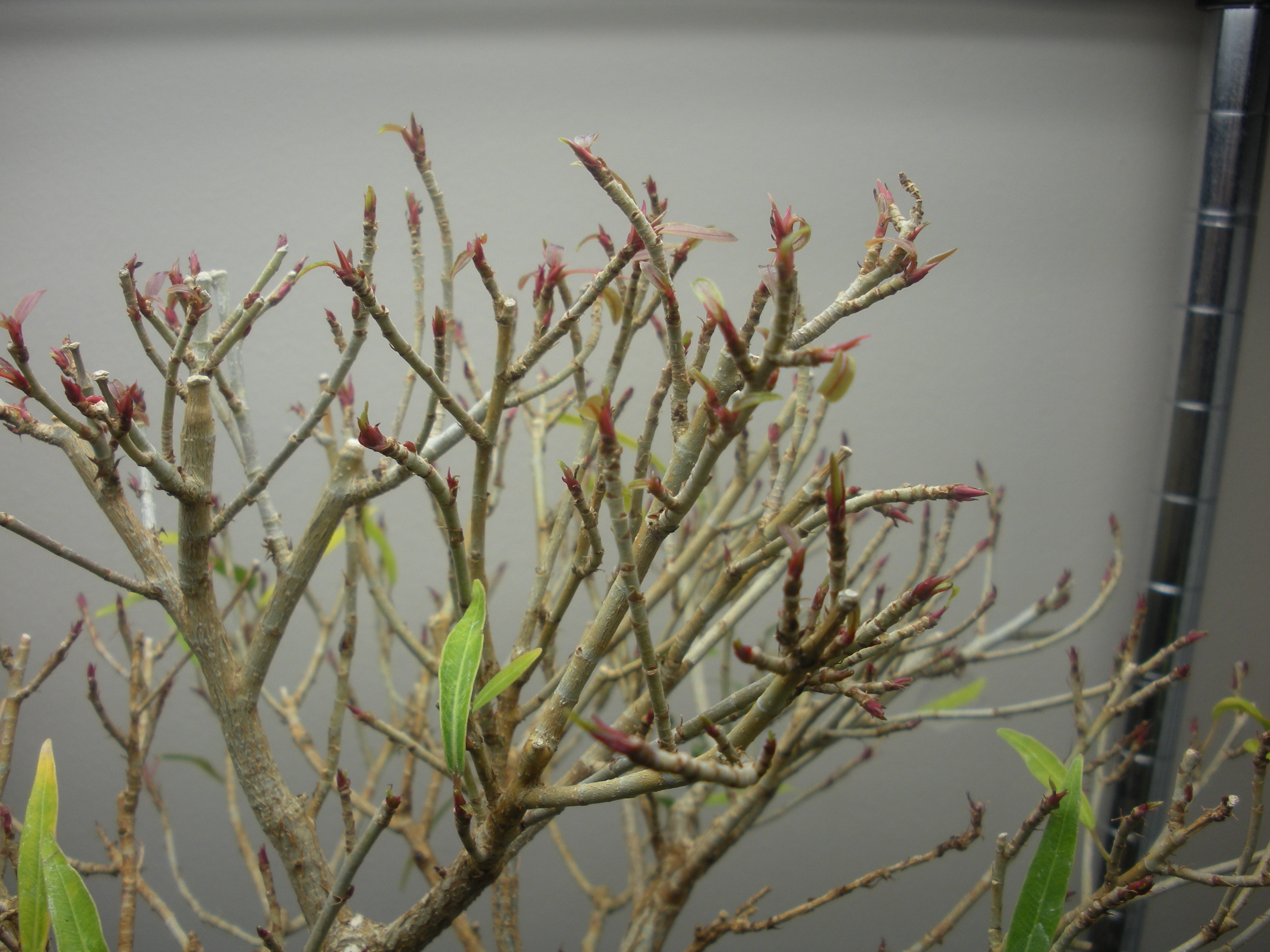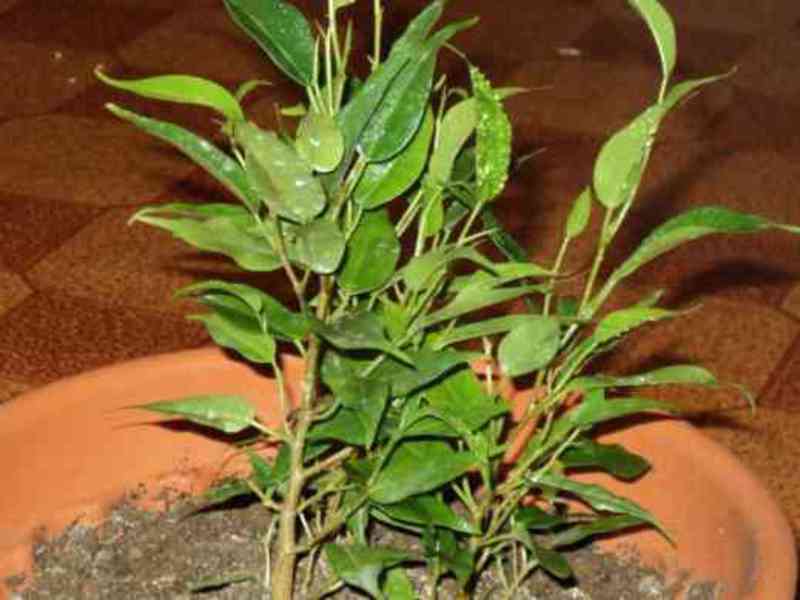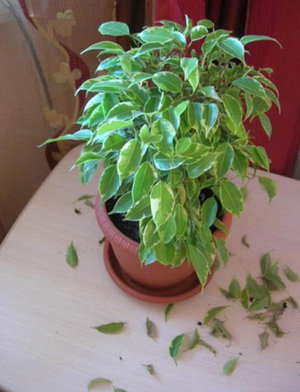
Benjamin's leaves are falling. For what reasons do ficus leaves fall.
So, as we have already established in the previous part of the article, one of the most popular questions about ficus is the question: "Why do ficus Benjamin leaves fall". After reading this article, we suggest that you definitely read the first part, which lists the other causes of leaf fall.
As long as we continue.
Listen to article
Why do ficus benjamin leaves fall
Cool air.
Ficus Benjamin does not like not only temperature changes, but also when the house is too cool or too hot. The temperature comfort zone for him is 17-23 ° C, and in order to maintain this temperature throughout the year, you need an air conditioner, preferably immediately with the function of humidifying the air. But remember that the ficus should be located away from the air conditioner, and even better - in the next room, which has air exchange with the one where the air conditioner is located.
Dry air.
 Benjaminchik does not tolerate heat and too dry air, which is the most common cause of leaf fall. Therefore, you will often have to spray the plant - 2-3 times a day, but from a fine spray gun from a distance of 20-30 cm. But it is best to buy an air humidifier.
Benjaminchik does not tolerate heat and too dry air, which is the most common cause of leaf fall. Therefore, you will often have to spray the plant - 2-3 times a day, but from a fine spray gun from a distance of 20-30 cm. But it is best to buy an air humidifier.
Wrong watering.
This mistake in plant care is also often the cause of leaf fall in Ficus Benjamin. And the difficulty of eliminating it lies in the difficulty of developing a formula for sufficient watering: you need to learn how to guess how much water your picky will have just right. With excessive watering, root rot may appear: the leaves weaken and begin to crumble. Insufficient soil moisture is also very harmful for the ficus, because, trying to keep the root system and the woody part in the right tone with a lack of moisture, the ficus gets rid of the leaves. After a series of waterings, he, of course, will depart, but it will take a long time to grow leaves.
How to avoid mistakes with watering? Check soil moisture. The soil mixture between waterings should have time to dry 1.5-2 cm deep from the surface. If the ficus is an adult, then even 3-4 cm. In winter, it is enough to water Ficus Benjamin 1 time in 7-10 days (depending on the air temperature: the colder the room, the less often you need to water it).
Moreover, Ficus Benjamin should be watered only with warm settled water.
Soil depletion.
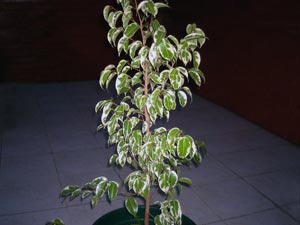 Another reason for leaf fall is soil depletion. If a flower grows for a long time in the same soil without a transplant, then it depletes the soil, and therefore the flower must be regularly fed with liquid fertilizers for decorative leafy plants. And it would be nice to pour fresh soil into the pot from time to time.
Another reason for leaf fall is soil depletion. If a flower grows for a long time in the same soil without a transplant, then it depletes the soil, and therefore the flower must be regularly fed with liquid fertilizers for decorative leafy plants. And it would be nice to pour fresh soil into the pot from time to time.
Ficus disease.
Well the worst reason falling leaves at Ficus Benjamin is a plant disease, namely the appearance of a spider mite on it. If you start the disease, all the leaves may fall off, and it will be difficult to cure the flower, so it is important to prevent the disease - maintain the correct air humidity and preventively treat the flower with a preparation for spider mites once every six months. For example, such as Fitoverm Rating 4.71 (21 votes)
There are about eight hundred varieties of ficus, which can take the form of a tree, shrub or creeper, can be evergreen or deciduous. At home, Benjamin's ficus, creeping ficus, rubber-bearing, lyre-shaped and other species are most often grown.
Most of them are unpretentious - these plants love well-lit places with diffused light, do not require frequent watering, tolerate low temperatures well in winter and even grow better in coolness, and love warmth in summer. Ficuses are intolerant of two situations: when they change their location or when they stand in a draft.
Ficus leaves live up to 2-3 years, then turn yellow and fall off, this is a natural process, new ones grow in place of fallen leaves, so a healthy plant always has a dense green crown.
If the ficus began to lose leaves faster and more abundantly, then you need to look for other causes of such a reaction and eliminate them.
Causes of falling leaves in ficus
One of the most common reasons why ficus leaves fall is a strong draft. These plants love calm air and respond to light breezes with yellowing and falling leaves. Find a suitable place for the ficus - with enough light and well protected from drafts. But remember that after a rearrangement, the plant gets used to a new place for a long time and reacts to the movement by dropping leaves in the same way. Ficuses are very susceptible to stress, and moving them from place to place can also cause leaves to fall. They react especially sharply if you put them in dark places.
A well-lit ficus quickly begins to be covered with new light green leaves.
Ficuses are unpretentious when it comes to watering, they can withstand prolonged drying out. But these plants do not react well to waterlogging, if they are watered often and plentifully, the leaves may also fall off. If this is the reason, then you need to take a break in watering for two weeks. If, as a result, the ficus continues to lose leaves, then this means that the roots have had time to rot - the flower needs to be transplanted by removing the rotten roots.
Despite the fact that ficuses do not tolerate too wet soil, they love humid indoor air - ideally about 75%. Dry air also leads to the dropping of leaves, so it is advisable to spray the plant more often.
Sometimes the ficus sheds its leaves due to a lack of nutrients, in which case it is necessary to feed it with minerals and organic fertilizers twice a month in spring and summer. Also make sure that pests do not start on the plant, such as the red spider mite, which causes the appearance of small white spots on the leaves and their fall.
Since ficuses do not like changes, it is advisable to immediately choose a specific place for it and not disturb the plant in the future.
Air temperature and lighting
In order to prevent the disease of ficuses, they should not be placed on marble and tiled floors and cold window sills, as the roots of these plants react painfully to cold. In winter, make sure that your pet does not come into contact with the window glass.
The best temperature for Benjamin's ficus is 18-25 ° C, warmer conditions are required for variegated individuals. At too high a temperature, the plant begins to suffer, its leaves begin to fade.
Since the ficus loves light, you should not keep it in a shaded place, but you should not put the plant in direct sunlight. A spacious bright room without drafts is best for your green friend.
Wrong watering
Ficus leaves may turn yellow and fall off due to proper watering. With excessive moisture, the roots of the plant begin to rot, which leads first to its disease, and then to death.If your plant has suffered from waterlogging, let the soil dry out for a week and a half to two weeks. During this time, the condition of the ficus should return to normal. If he does not feel better, you need to transplant the flower into another soil, removing the rotten roots before that and placing the root system in a container with a weak solution of potassium permanganate.
Pests and diseases
Ficus leaves can fall off due to fungal diseases, as well as pests - ticks, thrips, scale insects, aphids and mealybugs. Carefully inspect your green friend, if you find cobwebs, damage and the insects themselves on it, urgently treat the plant with special preparations.
iron deficiency
Young leaves often begin to turn yellow due to a lack of iron in the soil. In such cases, plants should be fed with ferrovit or iron chelate.
Ficus should be fed during the growth period, that is, from March to September. The day before the procedure, the plant must be watered so that the fertilizer does not burn the root system.
Related article
Indoor plants have always given freshness and comfort to our apartments and houses. Ficus is a small tree that can please the eye with its lush greenery. all year round. The natural habitat of this plant is the tropics and subtropical forests, but it is quite easy to care for it.
He is especially popular because he is very handsome and unpretentious. But sometimes its leaves may begin to turn yellow and fall off. There are a number of different reasons why this can happen. The very first thing you need to pay attention to is the soil. It should not be too wet, as this can cause leaf death. Also, an important role is played by the optimal temperature (especially in the cold season), the absence of drafts and sufficient lighting. It often happens that a sharp change in conditions has a bad effect on Benjamin's ficus: the leaves turn yellow and fall, the roots begin to rot, and uncharacteristic spots appear on the tree. There are also quite normal processes that Benjamin's ficus is subject to. Are the leaves below turning yellow and falling off? Don't worry. Like any other plant, it needs to update the foliage.
The lack of top dressing can also affect the health of the tree. It is important to choose such a tool so that it provides the most beneficial substances to Ficus Benjamin. The leaves turn yellow along the edge, and then crumble - which means that the plant does not eat as it should.
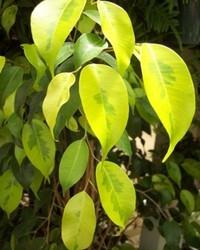
With insufficient air humidity, drying out of the soil or burns from the sun's rays, the ficus leaves begin to dry out, and then fall off. Determine and eliminate the causes of signs of drying leaves in time!
It is necessary to note the factors that can harm the health of the plant:
1. Negative consequences may have insufficient air humidity and temperature changes, this can affect Benjamin's ficus. The leaves turn yellow and fall, a spider mite has appeared - here you have the consequences of improper maintenance.
2. Excessive watering of the soil and stagnant water can lead to the death of the plant. The roots of the tree may begin to rot.
3. Do not also forget about where Benjamin's ficus comes from. Leaves turn yellow and fall off also due to lack of water in the soil. The tree becomes weak and lethargic.
4. Various plant diseases can cause cold watering and poor lighting levels.
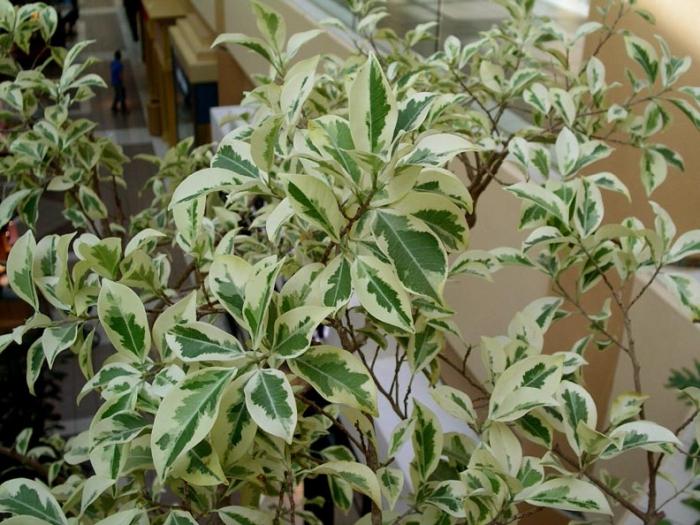
There are several simple rules care that will help you enjoy your favorite plant longer:
1. Ficus Benjamin loves sunlight, but it is worth considering that direct rays can damage its foliage. It is recommended to put the plant on windows facing east.
2. Stick to the average humidity. During the heating period, it is advisable to spray the plant more often.
3. In the summer, the tree needs to be fed. Once a month, mix top dressing with water and fertilize the soil in the container where the ficus grows.
4. Timely transplantation, which should take place every year, preferably in the spring. The drainage layer must be fairly thick so that a balanced moisture exchange occurs. Some time after the procedure, the plant may drop foliage.
These few rules will allow you to avoid problems with Benjamin's ficus and ensure his health for a long time.
Well, who said that caring for ficuses is not difficult? Even ordinary forms, under the wrong conditions of detention, immediately react with yellowing and dropping leaves. And how capricious are the variegated forms ...
But after all, this plant is very decorative and all efforts pay off a hundredfold with a lush crown and violent growth. After reading this article, you will not have to call your friends with the words: “I don’t know why ficus leaves turn yellow and fall off. What to do?".
Of course, we will not consider the natural aging processes. Losing a few yellow leaves in autumn or winter is quite normal. We will analyze exactly the mass yellowing and the strongest ficus leaf fall.
Wrong watering
The most common reason for a change in pigmentation and subsequent leaf fall is that you simply flooded the plant. Excess soil moisture provokes rotting of the root system, plus it remarkably helps all sorts of bacterioses and fusariums to kill your ficus. The leaves turn yellow throughout the plant, the soil begins to smell unpleasant. The bush itself becomes an incomprehensible dirty shade, sluggish. On the cut, instead of milky juice, a brown liquid is released.
What to do? Immediately stop watering the plant. It's best to leave him alone. It is strictly forbidden at this time to drag the pot and even turn around its axis. The only thing you can do is to put it on a pack of dry tissues or paper towels. Through the drainage holes, excess moisture should be absorbed into the loose paper.
After 5-7 days, the ficus is carefully examined again. If there is progress towards improvement, then first study the tips for proper care. Otherwise, you will completely finish off the poor fellow.
If no improvement is expected, then:
- They pull the ficus out of the old soil, gently shake it off.
- Under a gentle pressure of warm water, the roots are thoroughly washed.
- With a sterile blade or knife, cut off all rotten roots to healthy tissue. You definitely can't confuse them with anything. Diseased roots are soft, slippery, spread in the hands, smell unpleasant and dark, almost black, in color.
- All sections are sprinkled with crushed activated carbon and dried a little in the open air.
- Then the ficus is planted in another container and new soil.
At the same time, it is important to compact the soil so that the roots can immediately receive nutrition. Just don't put your foot down! Press lightly with palms.
In the first 2-3 weeks, you can not feed the ficus and rearrange it to another place. Subsequently, strictly observe the time and technology of proper watering, so as not to completely torture the plant.
Cold
In general, many problems are very clearly manifested in ficuses precisely by the yellowing of the leaves. And she loves to dump their plant as a passion! Do not feed with bread, let the fall fall.
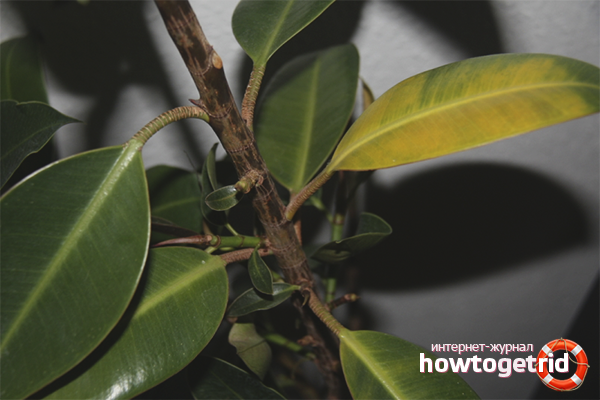
For example, cold ambient air, the slightest draft, cooling of the root system. Or in winter, a leaf touches the glass, looking, and it is already turning yellow.
What to do? In every possible way protect the ficus from the cold. A foam plate is placed under his legs, foamed insulation or even a cork stand. Even an ordinary board will do.
They protect him from drafts. They ventilate well, but make sure that they do not draw cold air. In winter, they move away from the glass or even put an insulator. It can even be a simple piece of woolen fabric or a piece of cardboard.
Water for irrigation should also not be cold from the tap right away or from a well. Room temperature will be optimal for drinking ficus. And it certainly won't overcool the roots.
Transfer
Ficuses are still those touchy. They really don't like being disturbed. Even a simple change of residence is fraught with yellowing and leaf fall. And here is the whole event! Transplantation is always stressful. After it, the ficus will definitely turn yellow and throw leaves.
What to do? Try to touch the flower as little as possible. Transplantation is not carried out annually, as some sources recommend, but only as needed. For example, when the roots begin to rise above the surface of the soil in a pot. At the same time, it is advisable not to gut the earthen clod, but only to transfer it entirely into a large container. Then the gaps are covered with new soil, pressed with hands.
It is important to know that after transplantation it is strictly forbidden to drink ficus! Therefore, they fall asleep new earth in a wet form. Then the flower is returned to its original place in the same position in relation to the light, as it was before. After about 8-9 days, you can carefully water the ficus for the first time. Well, then care and only care.
Micronutrient deficiency
Often flower growers seem to be dancing with a tambourine near the ficus and what they don’t get up to, and he, such a scoundrel, again every morning gives you his yellow leaves. What else does he lack? And he doesn't have enough food. Magnesium, iron and nitrogen are the trace elements that prevent premature aging and yellowing of the leaves.
What to do? Feed. Green liquid fertilizer is good, but it only provides nitrogen. A ficus needs a mineral. Feeding is done regularly, but little by little. Too much leads to the same result as not enough.
If you are not a supporter of the use of chemical fertilizers, then give your ficus to a person with the opposite worldview, and buy yourself an artificial one. He definitely won't budge.
Pests
Oh, those uninvited guests! Sometimes you don't notice them right away. And the leaves of the ficus, meanwhile, gradually turn yellow and fall off. Carefully inspect the underside of the blades. It is there that entire colonies of freeloaders are often concentrated.
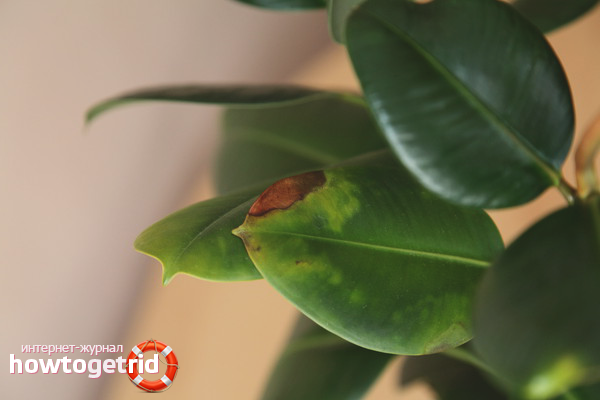
What to do? Poison mercilessly. Any systemic insecticide. And repeatedly. Most pests of indoor flowers just can not be removed. In the meantime, grandmother's infusions and decoctions from folk methods are being prepared, the ficus may die. After all, insects suck out all the nutritious juices and gnaw holes in the leaves.
Just strictly follow the instructions for use and do not exceed the dosage of the drug recommended by the manufacturer. This will not speed up the process of getting rid of pests, but it will definitely not bring benefits to the plant.
Diseases
They just don't show up. They arise from hypothermia of the root system, are transmitted from other infected plants, are transferred with purchased soil. Signs of the disease are difficult to miss. On the leaves, in addition to yellowness, brown spots of incomprehensible etiology appear. They grow rapidly, turning into weeping ulcers of a purple hue.
What to do? Rescue your pet immediately. Periodic spraying with any fungicide often corrects the situation and very quickly. In advanced cases, it is sometimes too late. In this case, you need to cut the cuttings from the remaining shoots and try to root them.
No doubt, an adult plant is a pity. But instead of him there will be several young ones.
By the way, for a quick recovery of a slightly affected ficus, it is recommended to use adaptogens. Epin, aloe juice or zircon very well activate the vitality of the plant and allow it to get stronger and recover from the disease faster.
Why do ficus leaves turn yellow and fall off. What to do? We know for sure. A capricious plant needs constant and proper care. Otherwise, your once lush bush can turn into a palm tree with a bunch on top. Or even worse, it will become an ikebana at all. Love your plants and take care of them.
Video: problems with ficus benjamin and their solution
Ficus benjamina is popular houseplant. Many flower growers fell in love with him for a wide variety of varieties and a beautiful view. True, this flower is very capricious, besides, it is finicky in care. For example, it sheds leaves more often than other domestic plants, since these lateral organs of the shoot, despite their attractiveness, are weak and do not tolerate negative environmental influences.
When not to worry?
Ficus Brilliant, like other small-leaved plants, can shed some leaves during the winter and autumn months. You don't have to worry about it if opal is not more than 10 pieces, as a rule, new leaves will appear in their place in the spring.
Why do leaves fall and turn yellow?
Irrigation mistakes.
 However, if the leaves began to fall off at other times of the year, or their number exceeds the norm, then you need to pay attention to watering. It is this mistake in caring for Benjamin's ficus at home that often leads to leaf fall. To eliminate such a problem, it is necessary to accurately calculate how much water will be just right for a picky plant.
However, if the leaves began to fall off at other times of the year, or their number exceeds the norm, then you need to pay attention to watering. It is this mistake in caring for Benjamin's ficus at home that often leads to leaf fall. To eliminate such a problem, it is necessary to accurately calculate how much water will be just right for a picky plant.
From too frequent watering in ficus root rot may occur, which leads to weakening and shedding of leaves. But insufficient soil moisture is also dangerous for him, because when trying to save the woody part and roots due to lack of water, the plant begins to get rid of the leaves. Of course, after a few waterings, it will recover, but it will grow leaves for a long time.
To avoid such mistakes in the care of ficus, you must constantly control soil moisture. The soil between waterings should have time to dry at least 1.5 cm deep from the surface. If the plant is an adult, then even 3 cm is better. In winter, it is recommended to moisten Ficus Brilliant once a week. In general, the colder the room, the less often you need to water. By the way, you only need to use warm water for this.
When yellowing of young leaves is observed on the ficus, then most likely the reason is a lack of iron. In this situation the plant can be fed:
- Ferrovit;
- iron chelate.
In this case, the soil in the pot should be damp. For example, you can first water the ficus, and the next day start feeding.
Even in the winter months, this tropical plant has a dormant period. Due to the lack of sunlight in the leaves, photosynthesis stops, the roots stop absorbing water, as in the summer, so it is better to reduce watering. It happens that the ficus Benjamin leaves are strongly shrink and twist, but do not lose their green color.
In addition, leaf fall near a tree can occur due to drafts and cold air, so the pot with it should be placed away from windows or balcony blocks.
Temperature regime
This plant feels good at a temperature of 18-25 degrees. If the room where it is located becomes too hot and stuffy, then the leaves begin to lose turgor, turn yellow and fall off. At temperatures below 18 degrees, the condition of the ficus deteriorates rapidly, especially when the container with the plant is kept on the windowsill, cold stone or marble floor. As a result, its roots are supercooled and irreversible processes occur, noticeable in the foliage.
Exposure to dry air
flower benjamin does not tolerate dry air and high temperatures, so you can often notice that his leaves are crumbling. What to do in this case? To prevent leaf fall, it is necessary to spray the ficus as often as possible from a fine spray gun from a distance of about 20 cm. But it is still better to put an air humidifier in the room.
Incorrect plant transplant
Ficus Benjamin should be transplanted once every two years. This period is considered optimal, since during such a time the roots of the flower will have time to completely braid the soil in the pot. The transplant is performed in the following way:
- First, the plant is pulled out of the container and shaken off excess soil;
- Then placed in another larger flowerpot;
- The bottom of the pot is covered with a drainage layer, and an earthen mixture is laid on top of it.
When a small gap remains between the walls of the flowerpot and the ficus in the container with the flower, this distance is covered with soil with fertilizers. At the end of all work, the plant must be watered.
Land depletion
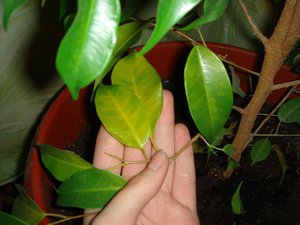 Also, the cause of shedding of leaves can be depletion of the soil. Why is this happening? For example, if ficus Benjamin grows for a long period in the same land without a transplant, then it drains the earth over time. To avoid this problem, you need to constantly feed the plant. For these purposes, liquid fertilizers for decorative and deciduous crops are mainly used. It is also advisable to regularly pour fresh earth into a pot with ficus.
Also, the cause of shedding of leaves can be depletion of the soil. Why is this happening? For example, if ficus Benjamin grows for a long period in the same land without a transplant, then it drains the earth over time. To avoid this problem, you need to constantly feed the plant. For these purposes, liquid fertilizers for decorative and deciduous crops are mainly used. It is also advisable to regularly pour fresh earth into a pot with ficus.
Ficus pests Benjamin photo
Sometimes ficus benjamin starts shedding leaves due to scab injury. The female of this pest sits motionless on the plant. It covers the laid eggs with itself and secretes a sticky secret that provokes the appearance of fungus. It is not difficult to remove an insect from a leaf, however, it is not always possible to completely get rid of it, since it has a wax shell that protects the scale insect from the action of insecticidal preparations.
You can remove this pest from the leaves with vodka or infusion of garlic. The top layer of soil will also have to be removed, as insect larvae may remain in it. Moreover, the procedure is repeated several times every week until the shield disappears.
The leaves of the Benjamin flower may turn yellow. in case of spider mites. These small pests up to 1 mm in length are able to multiply rapidly in dry and warm conditions. You can suspect their appearance on the plant by yellow and white spots on the leaves. If nothing is done, then after a while the thinned and discolored parts of the plant increase, which leads to the death and shedding of foliage.
Preventive measures
From proper care at home, Benjamin's ficus depends on his health and appearance. For prevention purposes, it is important to follow some tips when growing a flower:
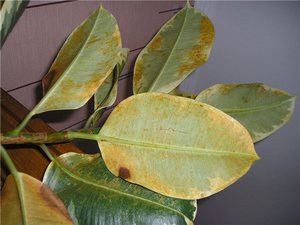
When growing a flower, it is necessary to use only high-quality planting mixture enriched with nutrients. If necessary, fertilizers can be applied to improve the nutrition of the ficus.
Why are the leaves still falling?
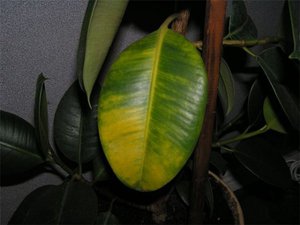 Sometimes the methods listed above do not give any results, and the leaves continue to crumble. In this case, this may be due to decayed root system. Remove the ficus from the flowerpot, carefully clean the roots from the soil, and inspect them. When they look like gray threads, besides very slippery, then the diagnosis is confirmed. Damaged ficus is transplanted into new soil.
Sometimes the methods listed above do not give any results, and the leaves continue to crumble. In this case, this may be due to decayed root system. Remove the ficus from the flowerpot, carefully clean the roots from the soil, and inspect them. When they look like gray threads, besides very slippery, then the diagnosis is confirmed. Damaged ficus is transplanted into new soil.
All rotten roots must be cut off, the same applies to dry and dead leaves. Then the root system should be soaked in a solution of potassium permanganate to disinfect it. The cut should dry well, after which it can be covered with foundationazole, charcoal powder or ground cinnamon. For transplanting, you need dry land. Water the planted plant for the first days will have to be moderate.
Diseases of ficus benjamin
